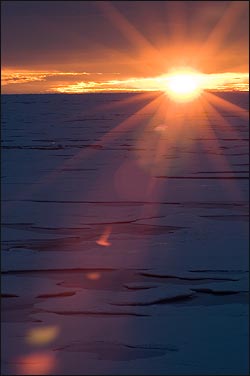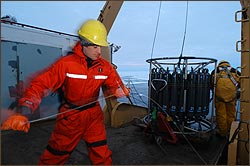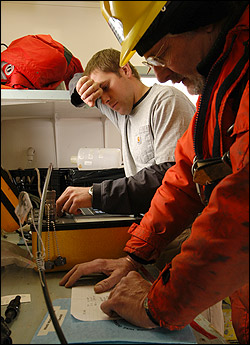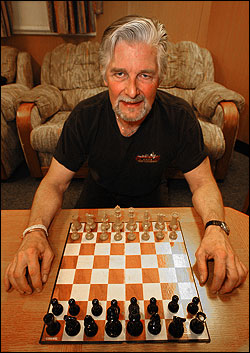Please note: You are viewing
the unstyled version of this website. Either your browser does not support CSS
(cascading style sheets) or it has been disabled. Skip
navigation.
Chris LinderAugust 27, 2005
Instead of the thin annual ice we were expecting today, we continued to batter through thick multi-year ice. Ice officer Lucie Theriault manned the crow's nest with a walkie talkie, guiding the Louis to the easiest passages. The leads, or open water areas in between the floes, are frozen now, with thin sheets of ice up to two inches thick. The ice sometimes buckles and bends before breaking, so thin it's almost elastic. I asked Lucie when we would break free of this thick pack ice. "The charts that we received several days ago indicated very light ice here" she told me. "However, the ice is always moving, and the wind has been out of the north for the past few days--it must have blown this thicker ice southwards." Heavy ice not only slows down our work, it's also expensive. When the Louis is using all of her power to break thick ice, the fuel cost can reach a hefty price of $1300 per nautical mile of progress. That's a lot of fuel, but it's the cost of doing business in one of the most inaccessible regions of the planet. In between CTDs and XCTDs this evening, we had a special party for science party member Doug Sieberg from the Institute of Ocean Sciences. After 31 years in oceanography, Doug is retiring. Doug was a member of the Louis' historic 1994 expedition to the North Pole, so it's fitting that his last cruise should be aboard this vessel. Gifts from the science party and crew members included a ceremonial hard hat decorated with knots, a photo of the Louis signed by everyone on board, and a trip to Woods Hole to visit the mooring operations group. This was my first cruise with Doug but he made an immediate impression. Tall and lanky, with a shock of silver hair, Doug is the epitome of a sailor. His weathered fingers always seem to be wrapped around some bit of line that he's tied into an elaborate knot. His smile is warm and friendly, and he's always eager to share his 31 years of seagoing wisdom. Doug has been leading a 12-hour CTD watch team and also lending two very experienced hands at every mooring deployment and recovery. He's always the first to jump forward and pitch in every step of the way from setup to cleanup. With seemingly boundless energy, he's happiest when his hands are busy with his lucky green-handled wrench. Bon voyage Doug, happy sailing into your retirement! Tomorrow Doug will be wielding the green wrench again, this time to help John Kemp and Kris Newhall deploy the fourth and last Beaufort Gyre Observing System subsurface mooring. After our difficulties at Mooring C, we are hoping for open water and sunny skies. Last updated: October 7, 2019 | ||||||||||||||||||||||
Copyright ©2007 Woods Hole Oceanographic Institution, All Rights Reserved, Privacy Policy. | ||||||||||||||||||||||






